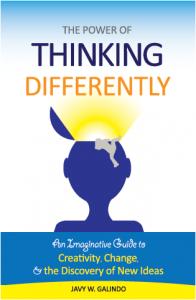Chapter 2 excerpt from The Power of Thinking Differently by Javy W. Galindo
—
For much of my creative research I was stumbling around in the dark, exploring different aspects of the creative process. It is akin to the allegory of the blind men and the elephant, where each perceives the elephant to be whatever part they were able to experience – the elephant is like a hosepipe for those feeling its trunk, a large fan for those feeling its ear, or a pillar for those feeling its leg.
In this same way, some experience the creative process as hard work and luck, while some believe it to be intersecting streams of ideas and perspectives. Some articulate it as removing oneself from ingrained beliefs and habits, while others see it as a four-step process. Yet others will think of it primarily as the ruminations of the unconscious mind or the unleashing of the creative spirit.
By exposing you to these various perspectives of the creative process, I wanted to share the different ways that it is often spoken of in popular culture, taught in seminars, and written about in creative thinking books. Each perspective is useful and with each analogy we are given a unique way to identify with the process of thinking differently.
But now, with the help of cognitive science, I want to shed light on a new analogy, one that helped me constellate all the perspectives we have reviewed thus far. Just as the description of a 4-step process has provided many with an easily graspable framework for creative endeavors, it can be useful to have an understanding of what the creative process entails. It can be helpful to have some sort of guide to help us contextualize what we feel and what we face as we try to think differently – an analogy or map that make it easier to identify where we are in the creative process, the obstacles that often stymie the process, and the actions needed to transcend these obstacles in order to continue our creative undertakings.
Just being exposed to great ideas about creativity will do you no good. Your enthusiasm will fade, and your memory of these ideas will also fade. You must gain an intimate familiarity with the creative process so you can confidently act upon your enthusiasm.
But how? How can so many people have different views of the creative process? Or in general, how can any of us look at the same thing and see completely different things – intersecting streams, hard work, unconscious mind, and spirit? It doesn’t seam reasonable.
These questions are at the heart of thinking differently. And there’s a completely reasonable explanation for this apparent incoherence.
By delving into the depths of neuroscience we will investigate how we commonly think, why we commonly think that way, and how we can learn to think differently. And, what we will soon find out is that our sense of reason is often unreasonable. We will discover that it is only by deviating from our common sense that we can gain not just a more creative perspective, but also a more complete one.
This will all become a bit clearer as we come down from our observation tower, tighten up our shoelaces, and begin to actually journey through the adventurous terrain of the creative landscape.
We will now explore thinking differently through the analogy of a heroic, creative journey.
—
Please leave comments, questions, and suggestions below.


